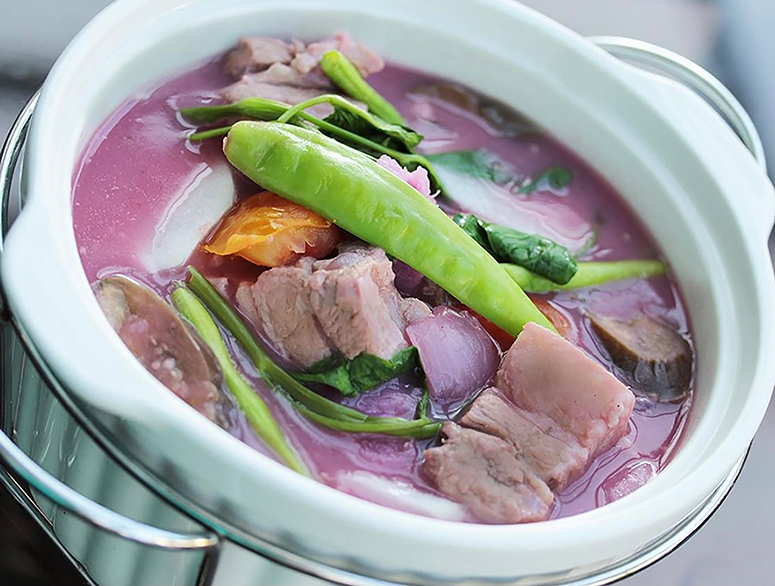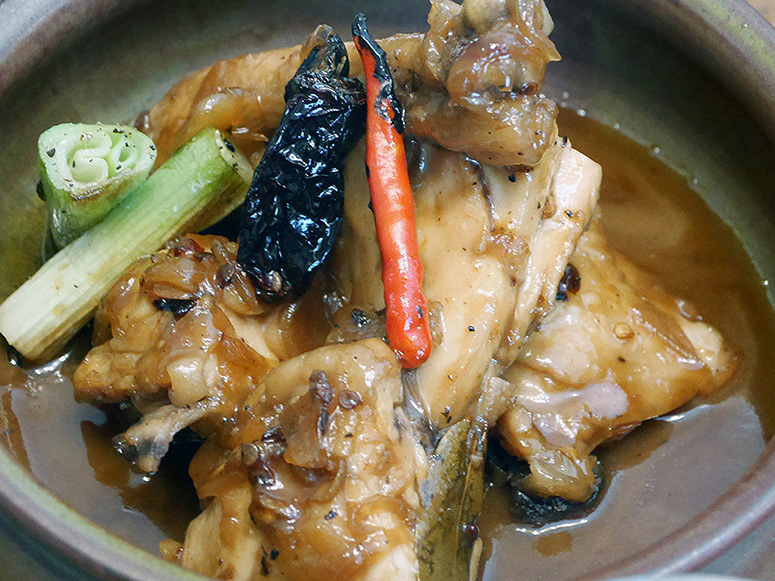The adobo riot: Much ado about nothing
Chefs, restaurateurs and netizens raised hell over a recent announcement by the Department of Trade and Industry-Bureau of Philippine Standards (DTI-BPS) forming a panel that will “develop a set of Philippine national standards when it comes to cooking adobo, sinigang, lechon, sisig, and other local dishes.”
The collective knee-jerk reaction was: “Nobody, but nobody, can standardize our dishes, more so especially our beloved adobo!” The writing on the wall spelled it out loud and clear: Adobo — noli me tangere (touch me not).
Déjà Vu
Caught in the vortex of this maelstrom are the designated panelists, well-respected chefs Glenda Barretto, Myrna Segismundo and Robby Goco. The former two were my co-authors in the seminal cookbook Kulinarya – A Guidebook to Philippine Cuisine, published in 2008. To date, more than 100,000 copies have been sold.
It must be recalled that when Kulinarya was still being planned, two years prior to its release, an avalanche of criticism against “standardizing” our dishes was thrown at the project. The book had been judged even before its printing.
Far from “standardizing” or even codifying the recipes, Kulinarya’s publisher Asia Society Philippines’ main mission was to promote greater understanding and appreciation of Philippine culture through our amazing food. It is a guidebook in capturing the essence of traditional Philippine cuisine, giving the best practices in its preparation and presentation for all to recreate, whether at home or in any part of the world.
And to address the controversial issue of the countless variants of adobo (“vinegar-braised,” in the Filipino context), eight kinds were featured, starting with the classic chicken and pork adobo (CPA) sa puti (seasoned with salt); CPA with toyo (soy sauce); chicken with gata (coconut milk); beef with atsuete (annatto seeds); crispy CPA flakes; adobong pusit (squid); adobong puso ng saging (banana blossom/heart); and adobong kangkong (water spinach).
‘Konting preno naman sana!’
In our chat group Food Writers Association of the Philippines (FWAP), chef Myrna admonished the group to exert some restraint before joining the netizens in condemning DTI.
“The exercise is not about the best adobo but just defining the baseline. Everyone's adobo is the best!” she wrote. “I will say this once: the issue is NOT about which adobo recipe/ version is better... Mama's, Lola's, Inday's, Iloilo, Pampanga, yours, mine, etc., etc. Before you all jump the gun and be trigger-happy, baka naman gusto niyo irespeto ang mga taong involved dito, like Glenda Barretto, Robby, myself. We are not that irresponsible. We can understand violent reactions from those we hardly know. Pero yung nandito sa thread na ito, konting preno naman sana!”
Wala naman dapat issue. The base ingredients of adobo were just defined — which ones are common to all adobo versions — and those are: garlic, vinegar/ acid, and a protein of choice.
As to the probable cause of all this brouhaha, she explained, “Wala naman dapat issue, eh. The base ingredients of adobo were just defined — which ones are common to all adobo versions — and those are: garlic, vinegar/ acid, and a protein of choice.
"All other ingredients added to it are recipe variations of the adobo. It’s as simple as that. Blame it on this writer assigned to DTI, who has the reputation of constantly twisting facts, to attract controversy (not from Philippine Star).”
Taking the bull by its horns, DTI was quick to respond. Here is its statement released on social media regarding the consultation process on the basic, traditional recipe for Filipino dishes.
“Adobo recipe ‘standard?’ Nothing to worry (about) on this. This is just among the many groundwork (initiatives) to develop more creative industry exports.
“There was a suggestion in the industry to have consultations among chefs and what will be in a traditional recipe, especially for international promotions (example, your adobo won't become paksiw or humba or your menudo won't become afritada), or we heard there's also adobo from Mexico.
“Again, this is for promotion abroad. Obviously, this is not a mandatory standard because there are thousands or millions of different ‘lutong adobo.’ The attempt is to define what we will promote internationally and not redefining what adobo is to different people now. A lot of creativity (is) going on and must be encouraged.”
‘Why fix it when it ain’t broke?’
Well said, DTI. But you’re not off the hook yet.
A netizen wrote: “What a waste of taxpayers’ money!”
Another one chimed in: “It is mentioned in DTI’s media releases that the Kulinarya cookbook is used as a reference for this project. Isn’t that redundant, making another guideline based from a well-established guideline? Kulinarya has already done it. Nobody will follow you, anyway. It’s an exercise in futility. Taxpayers’ money down the drain.”
The best way to preserve our food is when families pass down their heritage recipes to the next generation. The operative word is sharing recipes to show the depth and richness of our culinary heritage.
The award-winning book author and restaurateur Amy Besa wrote from New York: “Telling Pinoys how to cook and eat their comfort food is bound to be as successful as herding cats.
“The best way to preserve our food is when families pass down their heritage recipes to the next generation. The operative word is SHARING recipes to show the depth and richness of our culinary heritage. To standardize and codify means to EXCLUDE infinite ways of reimagining our food. INCLUSION and EMBRACING regional differences should be the spirit in which we learn about our food.”
Amen to that.
Authentic or not?
In one newspaper article (again, not in Philippine Star), BPS director Neil Catajay was reported to have said, “Standardizing the basic cooking technique for Philippine adobo will help ordinary citizens, foodies, and food businesses determine and maintain the authentic Filipino adobo taste.”
The crux of the matter is, did he really make that statement? If yes, the verbal stone throwing is justified; if not, it’s the reporter’s head that must roll.
The moral of the story? DTI and BPS, or any other government agency, must make press releases that leave very little room for interpretation or embellishment.
There are two keywords here that may seem trivial but will hit a very sensitive nerve if not properly addressed: “standardizing” has already been discussed above, while the second one, “authentic,” went unnoticed and almost got away.
DTI'S second target: Elusive ‘X’ factor
For argument’s sake, I’ll move on to the second target Filipino dish mentioned in the media release: sinigang. Make that “authentic sinigang taste.”

Sinigang is basically a clear-broth soup dish/ stew flavored with a sour fruit or the young, acidic leaves of a fruit-bearing tree (tomatoes and kalamansi are included). Any seafood or meat may be added, with a requisite combination of vegetables, i.e. kangkong, okra, gabi, sitaw, eggplant, banana heart, mustard leaves, radish, and the must-have green finger chilies.
It doesn’t vary much from these, making it a complete meal unto itself. It owes its popularity, not only to its readily available ingredients, its versatility as to its contents — depending on what the purse can afford — and the personal preference of the maker, but also mainly satisfying every Pinoy’s fondness for anything maasim, or sour.
When one takes a sip of the hot, sour broth, it will make you break into a sweat — a most welcome cooling effect in this warm climate of ours.
So, what is that elusive, “authentic sinigang taste?” In the absence of fresh seasonal sour fruits like kamias or green sampalok (tamarind), does using sinigang powder mix make it less authentic? And does using a non-traditional, foreign ingredient make it less authentic, too?

Take the sinigang sa bayabas (guava), for example. When the fruit was first introduced here by the Spanish friars from Mexico during the Galleon Trade (1565-1815), did the natives know what to do with it except to eat it as a fruit, or perhaps make into jams? But somehow it crept into the Pinoy palayok (clay pot) and was made into sinigang soup. And that’s pure Pinoy invention! How many years, centuries, will it take to call a dish “authentic Pinoy?”
Closer to contemporary times, take the sinigang ulo ng salmon (from Alaska), sa miso (Japanese), or the sinigang na corned beef (Irish/New York). Are they any less authentic because of the use of imported ingredients?
The latter, sinigang sa corned beef, was first introduced to the public when Sentro 1771 opened in Greenbelt Makati in 2002. It was a concoction by its executive chef, Vicky Rose Pacheco, finding a use for the broth produced in boiling her corned beef slabs served in another outlet. It became her runaway bestseller and has been much copied but never equaled.

Abé Restaurant serves a violet-colored sinigang with ubé (purple yam), while Manam has a reddish sour/sweetish soup with red watermelon.
Thank God for these creatives at home and in the food industry. Ours is a dynamic and living cuisine. And don’t let anybody tell us otherwise.


